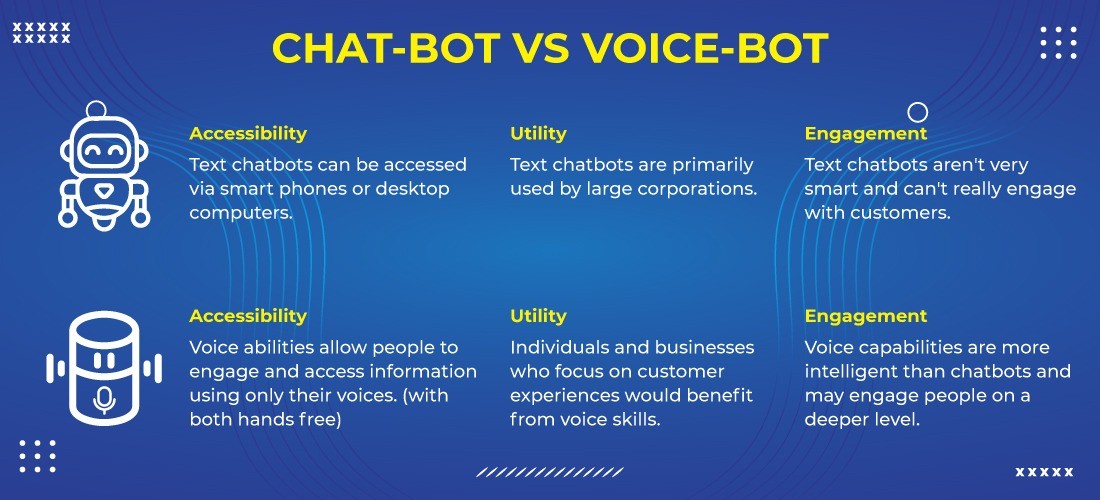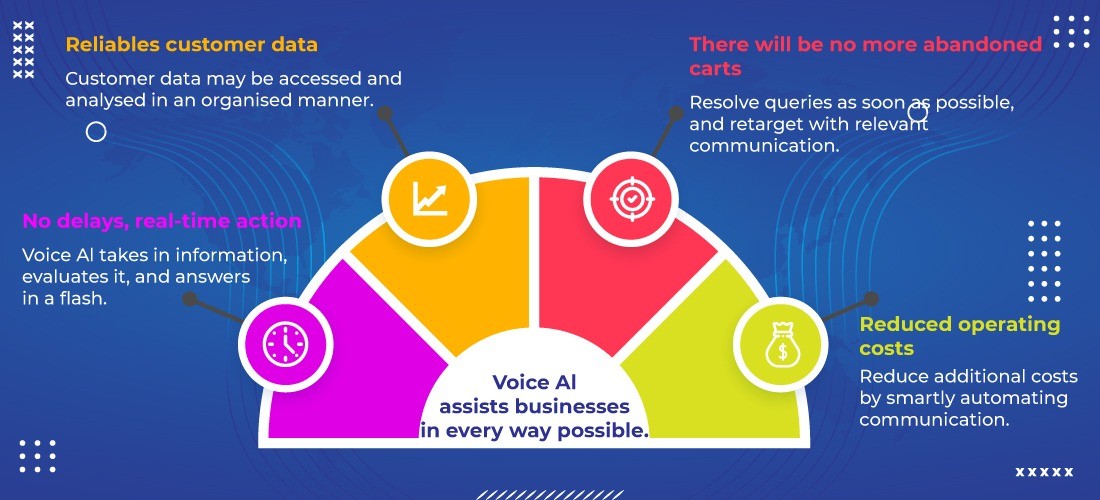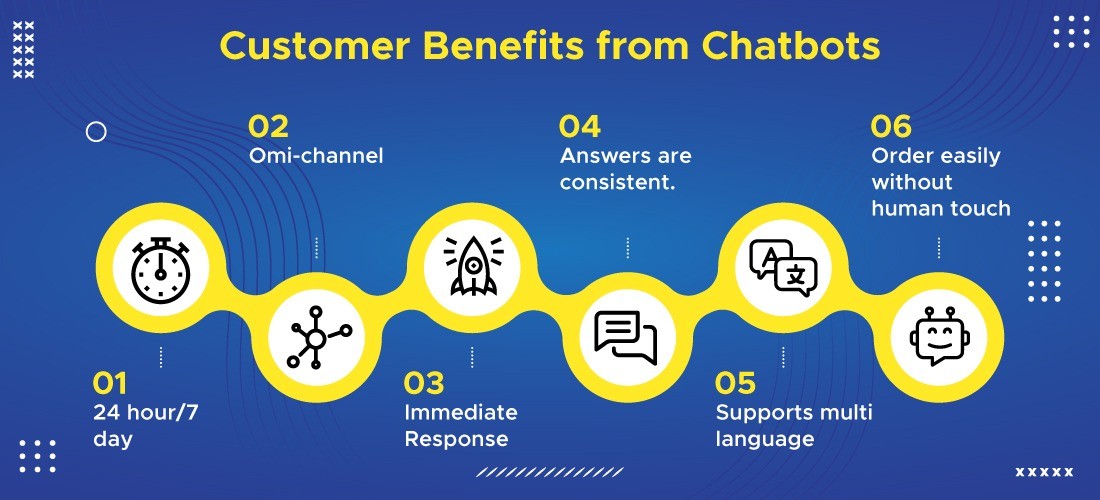Voicebot vs Chatbot: Artificial intelligence is unquestionably one of the most important aspects of technical progress in the twenty-first century.
Everything from smart speakers to self-driving automobiles is powered by this technology. Its beauty resides in its ability to constantly learn and train itself to adapt to new surroundings, allowing it to become self-sufficient.
Over the last decade, AI has expanded at a breakneck speed, with widespread acceptance.
According to a Deloitte survey on artificial intelligence, 75 percent of organizations would invest in AI-powered technology in the near future.
The use of AI assistants that can automate work for humans is one application of artificial intelligence that has radically impacted the way we do business.
AI-powered technology such as chatbots and voicebots are wonderful examples. These clever bots have the potential to make the difference between a positive and negative client experience.
Conversational AI is a fantastic method to engage with consumers while also improving the efficiency of your customer service processes.
According to Juniper Research, voice assistant transactions are predicted to increase by 320 percent to $19.4 billion by 2023.
We’ll lay down the fundamental between Voicebot vs Chatbot in this blog so you can decide which is best for your company.
What distinguishes voicebots from chatbots?

Using an AI assistant on your website to improve your customer experience, aid your support team with high contact volumes, and respond to clients 24 hours a day, 7 days a week with no downtime might be a game-changer. However, the issue remains: which of the two
should you choose for your company? The key distinction between voicebots and chatbots is that voicebots respond to voice instructions or directions whereas chatbots do not.
Let’s look at the advantages that both of these conversational AI bots have to offer.
The technology that powers voicebots and chatbots- Voicebot vs Chatbot
Before we get into the differences between Voicebot vs Chatbot, let’s look at the one thing they have in common.
We’re talking about natural language processing (NLP), which is what happens behind the scenes when you interact with a voicebot or a chatbot. With ASR, voicebot takes the technology one step further.
NLP is a technique that uses artificial intelligence to enable computers or bots to communicate with humans in natural language.
As more money floods into cutting-edge technology, the NLP market is predicted to grow 14 times its current size by 2025.
The following is how NLP works: It divides the input into smaller fractions by comparing it to the huge dataset with which it was trained to
detect parts-of-speech. It then considers how these various pieces of the input might be related to one another in order to make sense of it.
Natural language understanding (NLU) is a subset of natural language processing (NLP) that enables computers to grasp the meaning of messages and become more intuitive.
While natural language processing (NLP) aids both voicebots and chatbots, voice AI also use automated speech recognition (ASR) to break down complex human speech into fractions that the algorithm can consume and understand.
So, what’s the Voicebot vs Chatbot?
Why should you think about using a voicebot?

1. Use your voice to communicate quickly.
Voice Bots allow you to communicate with AI simply by speaking to it. Voice Bots are suitable for people of all ages and demographics.
The bot’s ease of use allows even folks who aren’t extremely tech-savvy to utilize it and have a positive experience.
2. Improved customer engagement
Voice Bots function similarly to dialing a phone number or using WhatsApp to communicate with someone. In terms of user experience,
this increase in interaction and regularity in communication can set your website apart from the competition.
It may be interacting with the AI to see how it reacts to your words. It can also be taught to employ humour and other interesting stuff.
3. Increased collaboration– Voicebot vs Chatbot
You can easily integrate your voicebot with your CRM or make it accessible through smart speakers, allowing your customers to communicate with your AI voicebot from the comfort of their own homes.
This, once again, results in a more engaging and consistent customer experience. According to Juniper Research, voice assistant transactions are predicted to increase by 320 percent to $19.4 billion by 2023.
Voice Bots will be able to integrate even more in the future as a result of their increasing popularity.
Now it’s time to make the case for chatbots

For nonlinear user journeys, this is the place to go.
Chatbots are ideal for navigating convoluted conversation processes. It’s perfect for non-linear user journeys when the chatbot presents a lot of options that don’t need to be remembered.
Chatbots employ user-friendly interfaces to simplify complex use cases.
It’s a lot easier to train.
It’s far easier to train a chatbot than it is to train a voicebot.
In comparison to voice data, there are larger datasets of text-based data available. When utilizing voicebots, users tend to speak longer sentences, whereas when using chatbots, users tend to type shorter sentences.
Another important consideration is that chatbots rely heavily on the user’s choice of words to understand them.
Voice bots, on the other hand, must take into account modulation, tone, and other aspects of spoken language.
Make better use of audiovisual media. – Voicebot vs Chatbot
Chatbots can interact in a variety of ways, including text, images, videos, GIFs, and more! However, voicebots are limited to audio-based media, which can make the experience richer and more engaging.
In the end, should you use voicebots or chatbots?
Voicebot vs Chatbot: This question does not have a one-size-fits-all response. If you’re asking which is better, chatbots or voicebots, the answer is that it depends on what works best for your consumers and the challenges you’re trying to solve.
Finding the overlap between your firm’s aims and your users’ goals is a great method to locate the sweet spot for your business.
The amount of data to be conveyed, the types of media that can be employed, and whether the user journey is linear or nonlinear are all factors to consider.
Read More: Conversational AI in Banking: The Top 10 Use Cases in 2021







